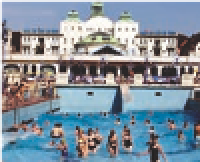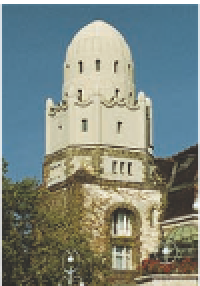Travel Reference
In-Depth Information
$
Terrace
^
Bath Foyers
There's no better
place to enjoy a hearty
and relaxed Sunday
brunch in Budapest
than on the well-shaded,
irst-loor terrace of the
Gellért Hotel. The
panoramic views from
here over the Danube
and the city are simply
magniicent.
There are three foyers
at the entrance. The cen-
tral foyer's glass roof is
the highlight, but the
loors, walls, statuettes
and benches of the others
are all marvellous as well.
A small fee entitles you to
walk around without actu-
ally entering the baths.
&
Main Swimming
Pool
The stunning Neo-
Classical main pool
(left)
is the inest part of the
Gellért baths. Surrounded
by high galleries and mar-
ble columns, it is decorat-
ed with colourful mosaics.
Don't miss taking a dip, as
swimming here is indeed
a luxurious experience.
)
Eastern-Style
Towers
Although the Gellért is
primarily a Secessionist
building, its cylindrical,
Eastern-style towers
(above)
commemorate
the earlier Turkish baths
which stood on this site.
*
Outdoor Pools
During the summer,
bathers head to the
hotel's outdoor pools
(above)
and sun terraces.
The main outdoor pool
was one of the irst in
the world to have an arti-
icial wave mechanism,
which is still in use today.
Healing Waters
Although Budapest is
known for its baths, few
visitors realize the major
role they play in city life,
and how much faith the
locals place in the heal-
ing properties of their
waters. For many of the
city's older residents,
the baths remain as
important as they were
under the Ottomans,
who developed the
potential of Budapest's
astonishing 120-odd
thermal springs. Most of
the city's thermal
waters are highly sul-
phurous, and are said to
be especially effective
in treating rheumatism,
arthritis and even
Parkinson's disease.
%
Café Eszpresszó
(
Thermal Baths
An old-fashioned
coffee and teahouse with
a range of cakes and pas-
tries
(below)
. You are
served by liveried wait-
resses, and the Viennese-
style furniture adds to the
splendour of the place.
The medicinal waters
at this site were irst
discovered in the 13th
century during the reign
of King András II. During
the Middle Ages, a hos-
pital was built at this spot.
Today, there is a great
network of thermal
baths at various
temperatures.
Currently under-
going renovation
work, one bath
will always be
kept open.
17












































































































